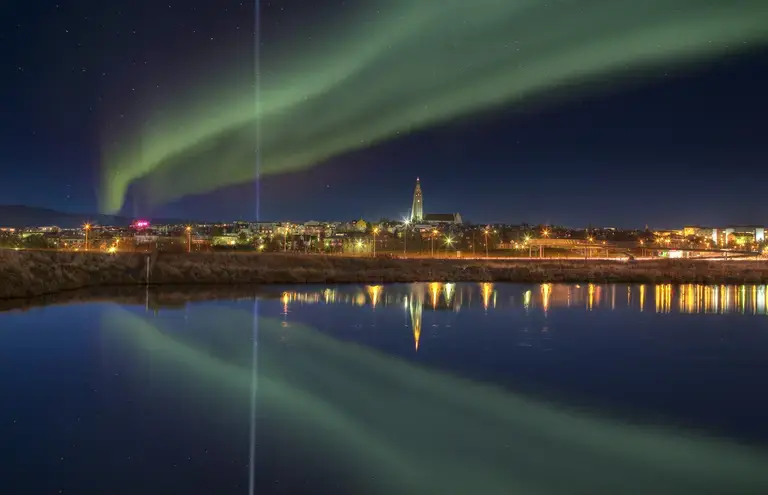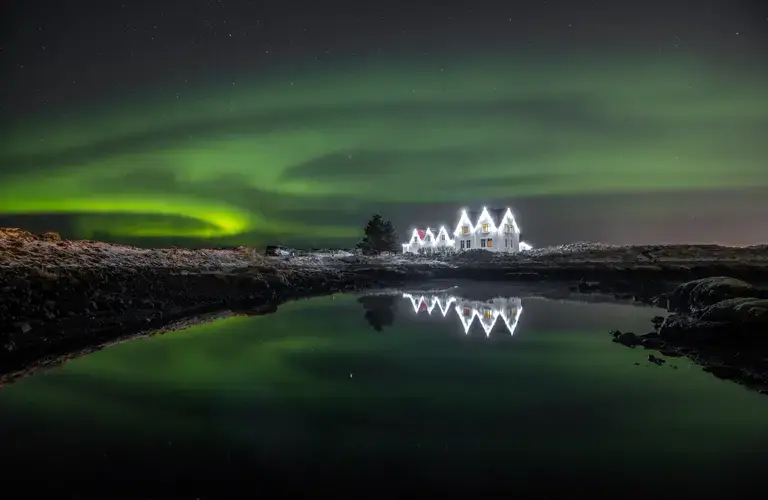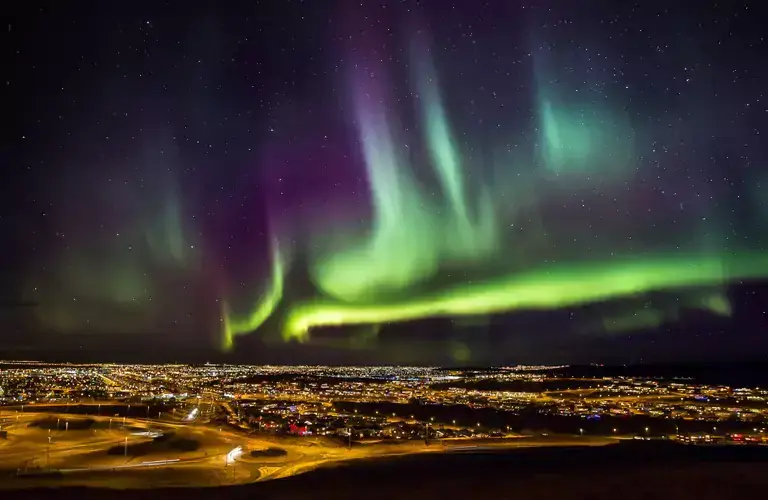
Reykjavík is One of the Best Places in the World to See the Northern Lights
If seeing the Northern Lights is on your bucket list, there’s no better place—or time—than Reykjavík in 2025 and 2026. Nestled at 64° north, Iceland’s capital is one of the most accessible and aurora-active cities in the world. Why? Because it sits directly beneath the auroral oval, the zone where Northern Lights activity is at its most intense and frequent.
Whether you're strolling past Hallgrímskirkja Church, walking along the seaside paths, or exploring Reykjavík’s cozy neighborhoods, there’s always a chance the sky above you could erupt in color. And if you want an even clearer view, you're just a short trip away from darker areas—20 to 30 minutes by car, bus, bike, boat, or even on foot.
Why Reykjavík Is Ideal for Aurora Spotting
See the lights right from the city. You don’t need to go far—just look up! On active nights, the lights are visible from downtown.
Step into nature within minutes. Quick access to darker skies just outside the capital enhances visibility.
Indoor experiences for any weather. Don’t miss the Perlan Aurora Show, Aurora Reykjavík – The Northern Lights Center, or Aurora Basecamp's cozy geodomes.
Easy and inclusive. No special gear or mountain treks needed—it’s a free, magical experience anyone can enjoy.
Why 2025/2026 Is the Time to Go
We’re on the cusp of a solar maximum—the peak of the sun’s 11-year activity cycle, expected in 2025. What does this mean for Northern Lights chasers?
More intense and frequent displays
Extended aurora season into spring and fall
Vivid and rare colors like red, pink, and blue
Dramatic, fast-moving waves of light across the sky
In short: this will be one of the best periods in over a decade to witness the aurora borealis—and Reykjavík is the perfect place to do it.
What Are the Northern Lights, Anyway?
The Northern Lights, or aurora borealis, are a cosmic dance of light caused by interactions between the sun and Earth’s atmosphere. Here’s how it works:
The sun releases charged particles, known as solar wind.
These particles travel toward Earth, guided by its magnetic field.
When they collide with gases like oxygen and nitrogen in our upper atmosphere, energy is released as light.
The result? The stunning waves of green, purple, and pink we call the Northern Lights.
Aurora Colors and Their Meaning:
Green: The most common color, caused by oxygen at lower altitudes.
Pink and Purple: A mix of nitrogen and oxygen.
Red: Rare and dramatic—oxygen at very high altitudes.
Blue: Caused by nitrogen, often seen during intense activity.
Astro Alexandra Explains the Northern Lights
How to Maximize Your Viewing Chances in Reykjavík
Even with increased solar activity, the right conditions help ensure a magical show:
Darkness: Best seen after sunset—especially between 9 PM and 2 AM
Clear Skies: Minimal cloud cover is key
Low Light Pollution: Head to areas like Grótta Lighthouse or Öskjuhlíð forest
Check daily conditions at icelandatnight.is
icelandatnight.is offers up-to-date aurora forecasts, real-time cloud cover maps, and viewing tips—perfect for planning your night out under the stars.
Myth Busted: You don’t need freezing temperatures to see the lights! That said, colder air can mean clearer skies.
Bonus: Keep an eye out for Glitský—rainbow-like polar stratospheric clouds that occasionally grace Reykjavík’s winter skies.
How to Photograph the Northern Lights
Want to capture the aurora magic on camera? Here are a few simple tips:
- Use a tripod: Even minor movements blur night shots.
- Manual mode: Adjust ISO (800–3200), aperture (f/2.8–f/4), and a longer shutter speed (5–20 seconds).
- Focus on infinity: Autofocus doesn’t work well in the dark—switch to manual.
- Use a wide-angle lens: To capture as much of the sky as possible.
- Don’t forget your phone! Newer models with Night Mode can also produce stunning shots—just keep your hand steady or rest your phone on a surface.
Get more tips on how to catch the perfect picture HERE.
A Once-in-a-Decade Opportunity
Reykjavík offers more than a glimpse of the aurora—it provides a truly personal and unforgettable connection with the natural world. There’s something powerful about seeing the Northern Lights from a vibrant, welcoming city where you can experience Icelandic culture and nature in harmony.
Whether you’re capturing every moment or just standing still under a glowing sky, the 2025–2026 aurora seasons promise unforgettable beauty—and Reykjavík is the perfect place to be.
Plan Your Aurora Adventure
Reykjavík offers something for every type of traveler—whether you're solo, with family, or on a romantic escape. Choose from:
Bus and boat tours
Super jeep excursions into the Icelandic wilderness
Peaceful nature walks just outside the city


